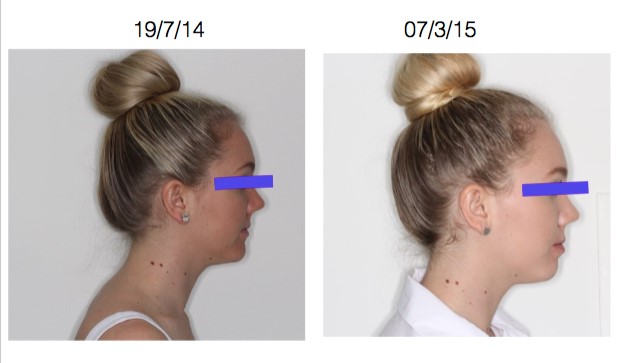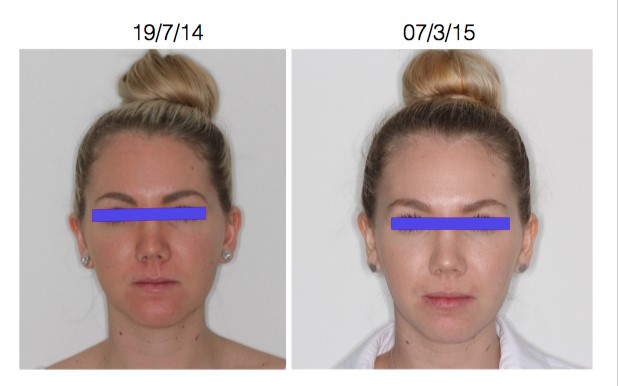One technique to extend your jaw is through jaw exercises. Just like any other muscle in your body, your jaw muscles can be strengthened through regular exercise. These exercises involve moving your jaw in different directions, such as opening and closing your mouth, moving your jaw from side to side, and pushing your lower jaw forward. By consistently performing these exercises, you can increase the strength and definition of your jawline.
In addition to jaw exercises, another technique to extend your jaw is through proper posture. Maintaining good posture not only benefits your overall body alignment but also contributes to a more defined jawline. When you have poor posture, your head tends to tilt forward, causing your jaw to recede. By consciously sitting and standing up straight, you can align your jaw properly and prevent it from sagging.
Extending your jaw not only enhances your facial appearance but also has several health benefits. A strong jawline can improve your chewing ability, which in turn aids in proper digestion. Additionally, a well-defined jaw can also help alleviate certain sleep disorders, such as sleep apnea, by keeping your airways open during sleep. Furthermore, a strong jawline can contribute to better oral health by promoting proper teeth alignment and reducing the risk of dental problems.
Importance of Jaw Extension
Jaw extension is an important technique that can have numerous benefits for both dental health and overall well-being. It involves stretching and extending the jaw muscles and joints to improve their flexibility and functionality.
One of the main reasons why jaw extension is important is because it helps to alleviate tension and stress in the jaw area. Many people experience jaw pain and discomfort due to factors such as teeth grinding, clenching, or temporomandibular joint (TMJ) disorders. By practicing jaw extension exercises, individuals can help to relieve these symptoms and promote relaxation in the jaw muscles.
In addition to relieving pain, jaw extension can also improve facial aesthetics. The jawline is an important aspect of facial appearance, and a well-defined jawline can contribute to a more attractive and youthful look. By extending the jaw, individuals can enhance the definition of their jawline, leading to a more aesthetically pleasing facial profile.
Jaw extension is not only beneficial for cosmetic purposes, but it also plays a crucial role in dental health. Proper jaw alignment is essential for maintaining healthy teeth and gums. When the jaw is misaligned, it can lead to issues such as malocclusion, which can affect the bite and cause problems with chewing and speaking. By practicing jaw extension exercises, individuals can help to improve their jaw alignment and prevent dental issues.
Furthermore, jaw extension can also have a positive impact on speech improvement. The position of the jaw plays a significant role in speech production, and a misaligned jaw can affect speech clarity and pronunciation. By extending the jaw, individuals can improve their articulation and enhance their overall speech quality.
Another important benefit of jaw extension is its role in sleep apnea treatment. Sleep apnea is a condition characterized by interrupted breathing during sleep, and it is often caused by a narrow airway. Jaw extension exercises can help to open up the airway and improve airflow, reducing the symptoms of sleep apnea and promoting better sleep quality.
Lastly, jaw extension can also be beneficial for individuals with TMJ disorders. TMJ disorders are conditions that affect the temporomandibular joint, causing pain, clicking, and limited jaw movement. By practicing jaw extension exercises, individuals can help to improve the flexibility and range of motion in the jaw joint, reducing the symptoms associated with TMJ disorders.
Different Techniques for Jaw Extension
Jaw extension refers to the process of stretching and elongating the jaw to improve its functionality and appearance. There are several different techniques that can be used to achieve jaw extension, each with its own benefits and considerations.
1. Orthodontic Treatment
Orthodontic treatment, such as braces or clear aligners, can be used to gradually shift the position of the teeth and jaw. This can help to correct bite issues and improve jaw alignment, resulting in a more extended jaw.
2. Maxillofacial Surgery
In some cases, maxillofacial surgery may be necessary to achieve jaw extension. This surgical procedure involves repositioning the jawbone to a more forward position, thereby extending the jaw. Maxillofacial surgery is typically recommended for individuals with severe jaw misalignment or structural issues.
3. Jaw Exercises
Performing specific jaw exercises can also help to extend the jaw. These exercises typically involve opening and closing the mouth, moving the jaw from side to side, and stretching the jaw muscles. Regular practice of these exercises can gradually increase jaw extension over time.
4. Oral Appliances

Oral appliances, such as jaw expanders or splints, can be used to extend the jaw. These appliances are custom-made to fit the individual’s mouth and are worn for a specified period. They work by applying gentle pressure to the jaw, encouraging gradual extension.
5. Physical Therapy

In some cases, physical therapy may be recommended to improve jaw extension. This can involve manual techniques, such as massage or manipulation, to stretch and mobilize the jaw muscles. Physical therapy exercises may also be prescribed to strengthen the jaw muscles and improve overall jaw function.
Benefits of Jaw Extension

1. Enhanced Facial Symmetry
One of the primary benefits of jaw extension is improved facial symmetry. When the jaw is extended forward, it can help correct asymmetry and create a more balanced appearance. This can have a significant impact on a person’s overall facial aesthetics and boost their self-confidence.
2. Reduced Wrinkles and Sagging Skin
Jaw extension can also help reduce the appearance of wrinkles and sagging skin in the lower face and neck area. By repositioning the jaw forward, it can tighten the surrounding muscles and tissues, resulting in a more youthful and rejuvenated appearance.
3. Improved Breathing and Sleep Quality

Jaw extension has been found to be effective in treating sleep apnea and improving breathing during sleep. By advancing the jaw, it helps to open up the airway and prevent obstructions, allowing for better airflow and reducing the risk of breathing difficulties and snoring.
4. Alleviation of TMJ Disorders
Temporomandibular joint (TMJ) disorders can cause pain, discomfort, and limited jaw movement. Jaw extension can help alleviate these symptoms by repositioning the jaw and reducing stress on the TMJ. This can provide relief from pain and improve overall jaw function.
5. Enhanced Speech Clarity
Jaw extension can also have a positive impact on speech clarity. By extending the jaw forward, it helps to create more space in the oral cavity, allowing for better tongue and vocal cord movement. This can result in clearer pronunciation and improved articulation.
Jaw Extension and Facial Aesthetics

Jaw extension is not only beneficial for dental health and speech improvement, but it also plays a significant role in enhancing facial aesthetics. The position and shape of the jaw have a direct impact on the overall appearance of the face.
When the jaw is extended, it helps to define the lower face and create a more balanced and harmonious facial profile. A well-defined jawline is often associated with youthfulness and attractiveness.
By extending the jaw, it can help improve the symmetry of the face. Many individuals may have a recessed or underdeveloped jaw, which can make the face appear imbalanced or disproportionate. Jaw extension techniques can help correct these issues and create a more proportionate and aesthetically pleasing facial structure.
In addition to improving facial symmetry, jaw extension can also help reduce the appearance of a double chin or sagging skin in the lower face. By extending the jaw forward, it helps to tighten the skin and muscles in the area, resulting in a more defined and youthful appearance.
Furthermore, jaw extension can have a positive impact on the appearance of the lips and mouth. When the jaw is extended, it creates more space in the oral cavity, allowing for better lip support and a fuller appearance. This can enhance the overall attractiveness of the smile and improve facial aesthetics.
Overall, jaw extension is an effective technique for improving facial aesthetics. It can help define the jawline, improve facial symmetry, reduce the appearance of a double chin, and enhance the appearance of the lips and mouth. By incorporating jaw extension into dental treatments, individuals can achieve not only better oral health but also a more attractive and balanced facial appearance.
Jaw Extension for Dental Health
Jaw extension is not only beneficial for improving facial aesthetics and speech, but it also plays a crucial role in maintaining dental health. The position and alignment of the jaw have a direct impact on the overall health of the teeth and gums.
Importance of Proper Jaw Alignment
Proper jaw alignment is essential for maintaining a healthy bite. When the jaw is misaligned, it can lead to various dental issues such as teeth grinding, clenching, and uneven wear on the teeth. This can result in tooth sensitivity, enamel erosion, and even tooth loss.
Jaw extension techniques help to correct misalignments and improve the overall alignment of the jaw. By extending the jaw, the teeth can come into proper alignment, reducing the risk of dental problems and improving overall oral health.
Prevention of Temporomandibular Joint (TMJ) Disorders
Temporomandibular Joint (TMJ) disorders are a common condition that affects the jaw joint and muscles. These disorders can cause pain, discomfort, and difficulty in jaw movement. Jaw extension techniques can help prevent TMJ disorders by promoting proper alignment and reducing stress on the jaw joint.
By extending the jaw, the muscles and ligaments surrounding the TMJ are stretched and strengthened, reducing the risk of joint dysfunction and associated pain. This can significantly improve the overall quality of life for individuals suffering from TMJ disorders.
Improved Chewing and Digestion

Jaw extension exercises can also improve chewing efficiency, which is essential for proper digestion. When the jaw is extended, it allows for better control and coordination of the chewing muscles, resulting in more effective breakdown of food particles.
Properly chewed food is easier to digest, allowing the body to absorb essential nutrients more efficiently. This can contribute to overall better oral and digestive health.
Jaw Extension and Speech Improvement
Jaw extension plays a crucial role in speech improvement. The position and movement of the jaw directly affect the clarity and articulation of speech sounds. When the jaw is properly extended, it allows for better control and coordination of the muscles involved in speech production.
One of the main benefits of jaw extension for speech improvement is the enhancement of vowel and consonant sounds. By extending the jaw, individuals can achieve a wider range of mouth opening, enabling them to produce sounds with greater precision and clarity.
Furthermore, jaw extension helps in the correct formation of specific speech sounds. Some sounds, such as /r/ and /l/, require the tongue to make contact with the roof of the mouth. Proper jaw extension provides the necessary space for the tongue to move freely and make the appropriate contact, resulting in improved pronunciation.
In addition to improving speech sounds, jaw extension also aids in overall speech fluency. When the jaw is extended, it allows for smoother transitions between sounds and words. This fluidity in speech production enhances the natural rhythm and flow of speech, making it easier for listeners to understand and follow the speaker.
Individuals with speech disorders, such as lisps or articulation difficulties, can greatly benefit from jaw extension exercises and techniques. These exercises focus on strengthening the jaw muscles and improving their range of motion, ultimately leading to improved speech clarity and intelligibility.
Jaw Extension for Sleep Apnea Treatment
Sleep apnea is a common sleep disorder that affects millions of people worldwide. It is characterized by pauses in breathing during sleep, which can lead to a variety of health problems if left untreated. One of the treatment options for sleep apnea is jaw extension.
One of the main benefits of jaw extension for sleep apnea treatment is the improvement in breathing and reduction in sleep apnea episodes. By moving the jaw forward, the airway is widened, allowing for a smoother flow of air and reducing the chances of breathing pauses.
Another benefit of jaw extension is the improvement in sleep quality. Sleep apnea can often lead to fragmented and restless sleep, resulting in daytime fatigue and decreased cognitive function. By treating sleep apnea with jaw extension, individuals can experience better sleep quality and wake up feeling more refreshed.
Jaw extension for sleep apnea treatment can also have positive effects on overall health. Sleep apnea has been linked to a variety of health conditions, including high blood pressure, heart disease, and diabetes. By effectively treating sleep apnea, individuals can reduce their risk of developing these conditions and improve their overall health.
Jaw Extension and TMJ Disorders
Jaw extension techniques can also be beneficial for individuals suffering from TMJ disorders. TMJ, or temporomandibular joint, disorders can cause pain and discomfort in the jaw joint and muscles that control jaw movement. These disorders can be caused by various factors, including stress, teeth grinding, or misalignment of the jaw.
By practicing jaw extension exercises, individuals with TMJ disorders can help alleviate their symptoms and improve their overall jaw function. Jaw extension exercises can help stretch and strengthen the muscles around the jaw joint, promoting proper alignment and reducing pain and discomfort.
In addition to exercises, other techniques such as jaw stretching devices or oral splints may also be used to help treat TMJ disorders. These devices can help provide support and relief to the jaw joint, allowing it to heal and function properly.
| Benefits of Jaw Extension for TMJ Disorders: |
|---|
| 1. Relieves pain and discomfort in the jaw joint and muscles. |
| 2. Promotes proper alignment of the jaw. |
| 3. Strengthens and stretches the muscles around the jaw joint. |
| 4. Improves overall jaw function. |
| 5. Helps reduce teeth grinding and clenching. |
| 6. Enhances the effectiveness of other TMJ disorder treatments. |
Overall, jaw extension techniques can be a valuable tool in managing TMJ disorders. By incorporating these exercises and techniques into a comprehensive treatment plan, individuals with TMJ disorders can experience relief from pain and discomfort, improve their jaw function, and enhance their overall quality of life.

Dr. Fidel Cann: Esteemed orthodontist with a lifelong dedication to enhancing smiles and oral health. Pioneering expertise, compassionate care.





